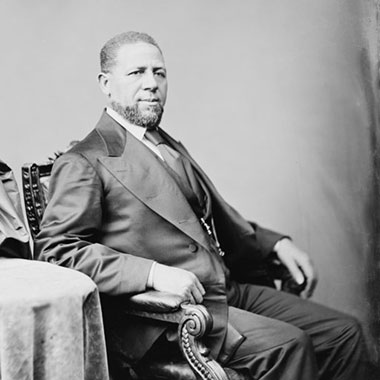
On February 25, 1870, Hiram R. Revels of Mississippi was sworn in as the first black U.S. Senator.
Senator Charles Sumner of Massachusetts, speaking that day on the importance of the event, said, “All men are created equal, says the great Declaration, and now a great act attests this verity. Today we make the Declaration a reality…. The Declaration was only half established by Independence. The greatest duty remained behind. In assuring the equal rights of all we complete the work.”
Hiram Rhodes Revels was born to free parents in Fayetteville, North Carolina, on September 27, 1827. In an era when educating black children was illegal in North Carolina, Revels attended a school taught by a free black woman. Revels attended Knox College in Galesburg, Illinois, on a scholarship from 1855 to 1857. He was one of the few black men in the United States with at least some college education.
When the Civil War broke out in 1861, Revels helped recruit two black regiments from Maryland. In 1862, when black soldiers were permitted to fight, he served as the chaplain for a black regiment in campaigns in Vicksburg and Jackson, Mississippi.
After the end of the Civil War, the primary task of the newly elected Mississippi state senate was to fill U.S. Senate seats. In 1861, Albert Brown and future Confederate President Jefferson Davis both vacated Mississippi’s U.S. Senate seats when the state seceded from the Union. On January 20, 1870, the Mississippi state legislature voted 85 to 15 to seat Hiram Revels in Brown’s former seat. (They chose Union General Adelbert Ames to fill Davis’s former seat.)
Nevada Senator James Nye underlined the significance of this event: “[Jefferson Davis] went out to establish a government whose cornerstone should be the oppression and perpetual enslavement of a race because their skin differed in color from his, what a magnificent spectacle of retributive justice is witnessed here today! In the place of that defiant man, who marched out to trample under foot the Constitution and the laws of the country he had sworn to support, comes back one of that race whom he would have enslaved forever to take and occupy a seat upon this floor.” On the afternoon of February 25, the Senate voted 48 to 8 to seat Revels, who subsequently received assignments to the Committee on Education and Labor and the Committee on the District of Columbia.
Radical Reconstruction
After the end of the Civil War, Radical Reconstruction was a period of transformation of the state and society of the Southern United States from 1863 to 1877.
At the time there were radical progressive members of the Republican Party. Their coalition came to power in nearly all the southern states and set out to transform the society by setting up a free labor economy, using the U.S. Army and the Freedmen’s Bureau. The Bureau protected the legal rights of freedmen, negotiated labor contracts, and set up schools and even churches for them. Lucy Parsons, a working-class leader and spouse of one of the Haymarket martyrs, worked for the Freedmen’s Bureau.
President Ulysses S. Grant supported Radical Reconstruction and enforced the protection of African Americans in the South through the use of the Force Acts passed by Congress. The Enforcement Acts were criminal codes that protected African Americans’ right to vote, to hold office, to serve on juries, and receive equal protection of laws. The laws also allowed the federal government to intervene when states did not act.
Grant used the Force Acts to suppress the Ku Klux Klan. Founded by Confederate army veterans, Klan groups spread throughout the South as an insurgent movement targeting freedmen and their allies. It sought to restore white supremacy by threats and violence, including murder, against blacks and white Republicans.
Meanwhile Southern Democrats who were the right-wingers of the time strongly opposed African-American political power. They alleged “widespread corruption, excessive state spending and ruinous taxes.” These Democrats who strongly opposed Reconstruction, regained control of the House of Representatives in 1874. The presidential electoral vote in 1876 was very close and confused, forcing Congress to make the final decision – Rutherford B. Hayes. The deployment of the U.S. Army was central to the survival of Radical Republican state governments; they collapsed when the Army was removed in 1877.
Reconstruction was a significant chapter in the history of civil rights in the United States; its destruction was a significant failure and setback for the country.
Leading authority on Reconstruction, Eric Foner stated, “What remains certain is that for blacks its failure was a disaster whose magnitude cannot be obscured by the genuine accomplishments that did endure.”
Suggested further reading:
Black Reconstruction in America, 1860-1880, by W.E.B. DuBois
Reconstruction: America’s Unfinished Revolution, 1863-1877, by Eric Foner
A Nation Under Our Feet: Black Political Struggles in the Rural South from Slavery to the Great Migration, by Steven Hahn
Photo: Hiram R. Revels. Wikimedia Commons.










